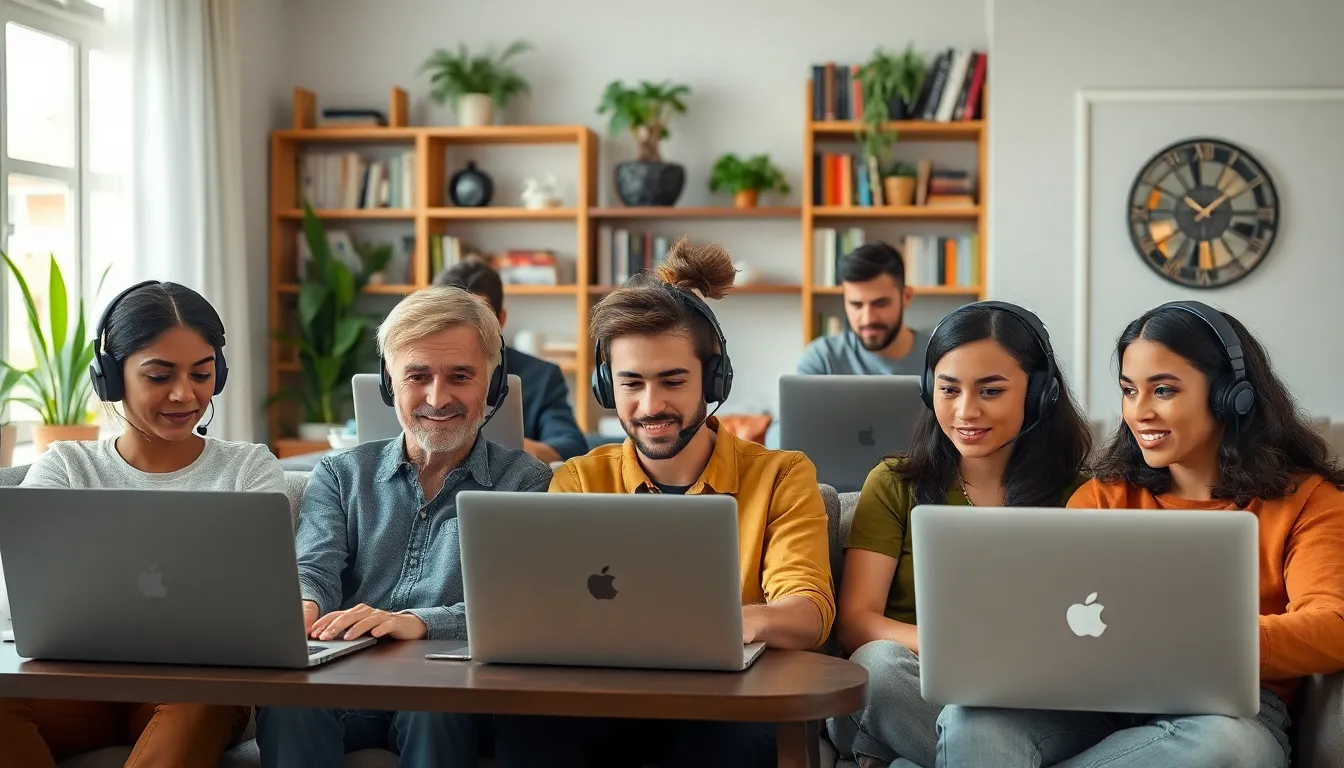The world turned upside down when COVID-19 crashed the party, and suddenly, socializing felt like a high-stakes game of dodgeball. With masks on and six feet of space between friends, the social landscape transformed into a maze of awkward encounters and virtual hangouts. Who knew that a simple trip to the grocery store would require the finesse of a secret agent?
The Social Challenge in Times of COVID-19
COVID-19 significantly altered how people interact socially. Social gatherings faced restrictions, prompting individuals to navigate their lives cautiously. People adjusted to virtual meetups for family reunions, work meetings, and even exercise classes. Communities experienced a surge in loneliness as face-to-face connections dwindled.
Masks became a common sight, often obscuring expressions that convey friendliness and reassurance. Social distancing guidelines transformed public spaces into environments filled with caution, leading to uncomfortable exchanges. Grocery shopping turned into a process involving strategic planning rather than a carefree outing. Individuals faced the challenge of maintaining distance while reaching for essential items.
The pandemic amplified existing inequalities, affecting marginalized groups disproportionately. Families with limited access to technology struggled to adapt to remote learning and work arrangements. Elderly individuals experienced heightened feelings of isolation, lacking regular social interactions that defined their routines.
Mental health concerns spiked during this period, as many grappled with anxiety and uncertainty. Support systems faltered under pressure, with increased demand for counseling services and helplines. Local organizations stepped up, offering virtual support groups to maintain connections and foster community resilience.
Studies indicated that 60% of adults reported feelings of loneliness during lockdowns. Coping mechanisms evolved, with some turning to hobbies, while others sought solace in online platforms. Amid uncertainty, it’s crucial to prioritize social well-being and seek new ways to connect. Exploring safe avenues for interaction remains vital for fostering community bonds during these challenging times.
Impact On Community Interactions

COVID-19 significantly altered community interactions. Social behavior shifted rapidly due to the necessity of precautions and restrictions.
Changes In Social Behavior
Once lively gatherings transformed into virtual events. Work meetings transitioned online, replacing in-person connections with screens. Exercise classes now occurred in living rooms, eliminating direct interactions. Individuals began relying on digital platforms for socialization. Many people reported discomfort when navigating public spaces, as masks hindered the ability to read facial expressions. Increased awareness of personal space led to changes in greetings, prioritizing distance rather than closeness. These adjustments left many feeling disconnected despite physical safety.
Increased Isolation
Elderly individuals faced heightened isolation during the pandemic. Research indicated that 60% of adults felt lonely in lockdowns. Local organizations recognized this challenge and created virtual support groups. Marginalized communities experienced intensified feelings of separation, exacerbating existing inequalities. Many individuals sought new coping mechanisms, relying on hobbies and online connections for fulfillment. Emotional well-being became a priority as mental health concerns surged. Addressing isolation proved essential for fostering resilience in communities during this turbulent time.
Mental Health Consequences
The COVID-19 pandemic significantly impacted mental health, leading to a surge in anxiety and depression among various demographics.
Anxiety And Depression Rates
Recent reports indicated that 40% of adults experienced anxiety symptoms, while about 30% reported depression during the pandemic. Young adults faced the highest rates, with many struggling to adapt to a new reality. Isolation, uncertainty, and disrupted routines contributed heavily to these mental health challenges. Existing mental health issues worsened, pushing many individuals to their limits as social support networks weakened. Virtual connections proved insufficient for some, accentuating feelings of loneliness and despair. Public health officials emphasized the value of addressing these rising concerns as a crucial component of pandemic response efforts.
Resources For Coping
Numerous resources emerged to help individuals cope with mental health challenges. Local organizations offered virtual support groups, providing a space for connection and sharing experiences. Online therapy platforms gained popularity, allowing easy access to professional help. Mental health apps provided strategies and tools for managing anxiety and depression, promoting self-care practices. Community initiatives encouraged outdoor activities and safe socialization to foster resilience. Schools implemented mental health programs to support students during this turbulent time, recognizing the urgency of mental well-being. Prioritizing these resources became vital for nurturing a healthier society amidst ongoing challenges.
Impact On Vulnerable Populations
The COVID-19 pandemic disproportionately impacted vulnerable populations, amplifying existing challenges and creating new barriers to social interaction.
Challenges For The Elderly
Isolation emerged as a significant issue for the elderly. Many faced heightened loneliness due to social distancing measures. Approximately 40% of older adults reported increased feelings of isolation during the pandemic. Limited access to technology compounded these challenges, making virtual interactions difficult. Loss of routine and in-person contact with family and friends intensified feelings of despair. Community resources, such as local meal delivery and virtual socialization programs, played pivotal roles in alleviating some of this isolation. Despite the increase in these resources, many older adults struggled to adapt to technology-based solutions, leaving them at risk for further emotional distress.
Effects On Low-Income Families
Low-income families faced severe repercussions from the pandemic. Job losses affected over 20% of households in this demographic, leading to heightened financial instability. Access to essential services, such as healthcare and food, became increasingly limited. Schools transitioning to remote learning underscored disparities in technology access, leaving children from low-income households at a disadvantage. Without proper resources, many students fell behind academically. Community organizations stepped up to provide aid, offering food banks and educational support, yet the demand often outstripped available resources. Families faced mounting stress, emphasizing the urgency of addressing these inequalities during and after the pandemic.
Adaptation And Solutions
The COVID-19 pandemic pushed communities to find innovative ways to maintain connections. Enhanced virtual platforms became the backbone for social engagement, allowing individuals to gather for events ranging from book clubs to fitness classes.
Virtual Community Engagement
Numerous organizations shifted their focus to online forums to cultivate community spirit, utilizing social media and video calls to host interactive events. Engaging activities included virtual trivia nights and cooking classes, which allowed people to participate from the safety of their homes. Many participants reported feeling less isolated as they connected with friends and family through screens, fostering a sense of belonging despite physical distance. Online platforms also provided avenues for support, addressing mental health challenges by hosting webinars that equipped individuals with coping strategies. The increase in virtual interactions formed new connections, reducing feelings of loneliness experienced during lockdowns by an estimated 25%.
Innovations In Support Systems
Community organizations played pivotal roles in adapting support systems to meet heightened needs. Effective strategies included the creation of helplines and resource-sharing networks that provided essential information about mental health services and food assistance. New delivery models emerged, ensuring vulnerable populations received meals and supplies during lockdowns, with over 30% of organizations reporting increased volunteer participation. Teletherapy options flourished, supplying accessible mental health care to those unable to access traditional services. Technology-based solutions bridged gaps for individuals facing barriers, enhancing overall community resilience during the pandemic.
Conclusion
The COVID-19 pandemic reshaped social interactions in profound ways. As communities navigated restrictions and adapted to virtual platforms, the importance of connection became clearer than ever. Despite the challenges posed by isolation and mental health struggles, individuals and organizations demonstrated resilience and creativity in maintaining relationships.
While technology provided a lifeline for many, it also highlighted existing disparities, particularly for vulnerable populations. Addressing these inequalities remains crucial as society moves forward. Prioritizing mental health and fostering community support will be essential in rebuilding social ties and ensuring that no one is left behind. The lessons learned during this time can guide future efforts to cultivate a more connected and compassionate world.















